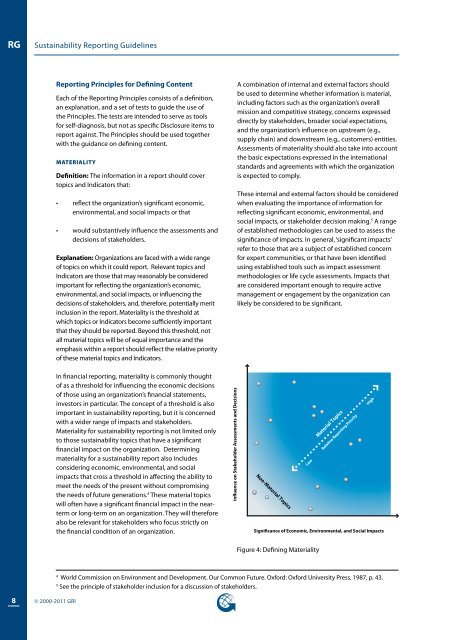G3.1 Sustainability Reporting Guidelines - Global Reporting Initiative
G3.1 Sustainability Reporting Guidelines - Global Reporting Initiative
G3.1 Sustainability Reporting Guidelines - Global Reporting Initiative
Create successful ePaper yourself
Turn your PDF publications into a flip-book with our unique Google optimized e-Paper software.
RG<br />
<strong>Sustainability</strong> <strong>Reporting</strong> <strong>Guidelines</strong><br />
<strong>Reporting</strong> Principles for Defining Content<br />
Each of the <strong>Reporting</strong> Principles consists of a definition,<br />
an explanation, and a set of tests to guide the use of<br />
the Principles. The tests are intended to serve as tools<br />
for self-diagnosis, but not as specific Disclosure items to<br />
report against. The Principles should be used together<br />
with the guidance on defining content.<br />
Materiality<br />
Definition: The information in a report should cover<br />
topics and Indicators that:<br />
• reflect the organization’s significant economic,<br />
environmental, and social impacts or that<br />
• would substantively influence the assessments and<br />
decisions of stakeholders.<br />
Explanation: Organizations are faced with a wide range<br />
of topics on which it could report. Relevant topics and<br />
Indicators are those that may reasonably be considered<br />
important for reflecting the organization’s economic,<br />
environmental, and social impacts, or influencing the<br />
decisions of stakeholders, and, therefore, potentially merit<br />
inclusion in the report. Materiality is the threshold at<br />
which topics or Indicators become sufficiently important<br />
that they should be reported. Beyond this threshold, not<br />
all material topics will be of equal importance and the<br />
emphasis within a report should reflect the relative priority<br />
of these material topics and Indicators.<br />
A combination of internal and external factors should<br />
be used to determine whether information is material,<br />
including factors such as the organization’s overall<br />
mission and competitive strategy, concerns expressed<br />
directly by stakeholders, broader social expectations,<br />
and the organization’s influence on upstream (e.g.,<br />
supply chain) and downstream (e.g., customers) entities.<br />
Assessments of materiality should also take into account<br />
the basic expectations expressed in the international<br />
standards and agreements with which the organization<br />
is expected to comply.<br />
These internal and external factors should be considered<br />
when evaluating the importance of information for<br />
reflecting significant economic, environmental, and<br />
social impacts, or stakeholder decision making. 5 A range<br />
of established methodologies can be used to assess the<br />
significance of impacts. In general, ‘significant impacts’<br />
refer to those that are a subject of established concern<br />
for expert communities, or that have been identified<br />
using established tools such as impact assessment<br />
methodologies or life cycle assessments. Impacts that<br />
are considered important enough to require active<br />
management or engagement by the organization can<br />
likely be considered to be significant.<br />
Establishing Materiality<br />
In financial reporting, materiality is commonly thought<br />
of as a threshold for influencing the economic decisions<br />
of those using an organization’s financial statements,<br />
investors in particular. The concept of a threshold is also<br />
important in sustainability reporting, but it is concerned<br />
with a wider range of impacts and stakeholders.<br />
Materiality for sustainability reporting is not limited only<br />
to those sustainability topics that have a significant<br />
financial impact on the organization. Determining<br />
materiality for a sustainability report also includes<br />
considering economic, environmental, and social<br />
impacts that cross a threshold in affecting the ability to<br />
meet the needs of the present without compromising<br />
the needs of future generations. 4 These material topics<br />
will often have a significant financial impact in the nearterm<br />
or long-term on an organization. They will therefore<br />
also be relevant for stakeholders who focus strictly on<br />
the financial condition of an organization.<br />
Influence on Stakeholder Assessments and Decisions<br />
Non-Material Topics<br />
Material Topics<br />
Low Relative <strong>Reporting</strong> Priority High<br />
Significance of Economic, Environmental, and Social Impacts<br />
Figure 4: Defining Materiality<br />
4<br />
World Commission on Environment and Development. Our Common Future. Oxford: Oxford University Press, 1987, p. 43.<br />
5<br />
See the principle of stakeholder inclusion for a discussion of stakeholders.<br />
8<br />
© 2000-2011 GRI

















